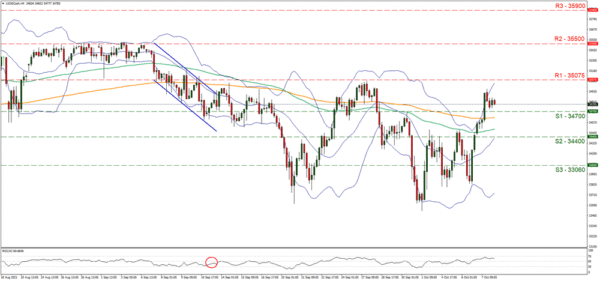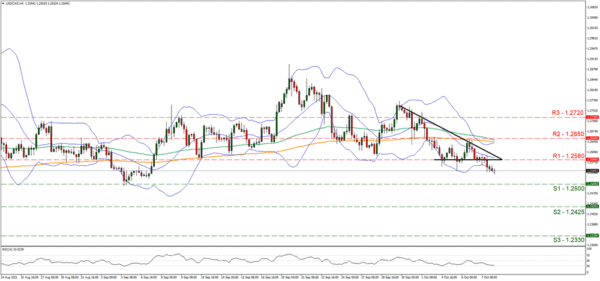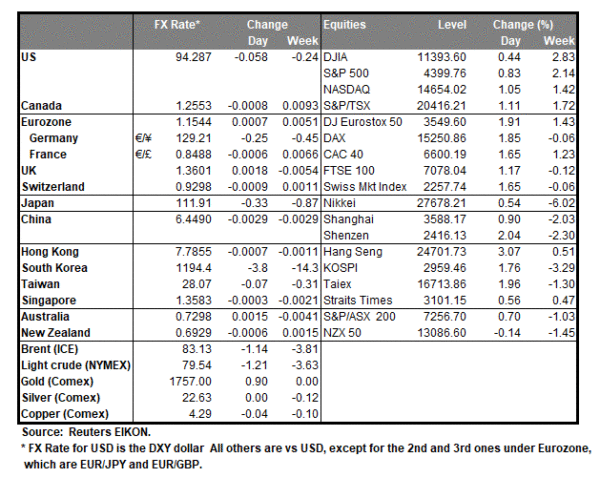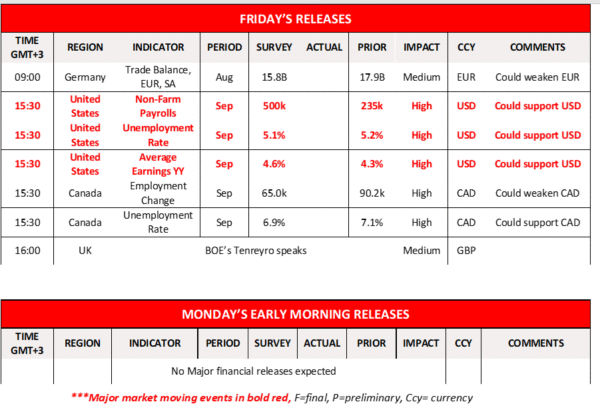The USD remained rather stable against its counterparts yesterday, yet started with some gains during today’s Asian session as the market’s focus is fixed on the release of the US employment report for September. The forecasts in general are for all main indicators in the report to align, pointing towards a tightening of the US employment market. Should the actual rates and figures meet their respective forecasts, they could boost the Fed’s confidence and enhance the possibility of announcing the tapering of the bank’s QE program in its November meeting. On USD fundamentals related to the debt ceiling of the US may have found a solution as US lawmakers seem to agree to raise the federal borrowing limit until December, creating substantial support for the US stockmarkets. On the monetary front it should be noted that Cleveland Fed President Mester yesterday was reported stating that inflation has surpassed the level required for a rate hike yet worries for the employment market persist.
Dow Jones rose yesterday breaking the 34700 (S1) resistance line, now turned to support. Despite the index’s rise we are hesitant to call the bulls as the index seems to have stabilised at later hours. It should be noted that the RSI indicator, below our 4-hour chart is above the reading of 50, which could imply an advantage for the bulls. Should the bulls actually take charge of the index’s direction we may see it breaking the 35075 (R1) resistance line and thus pave the way for the 35500 (R2) record high level. Should the bears take over, we may see the index breaking the 34700 (S1) support line and aim for the 34400 (S2) support level.
Canada’s employment data could send mixed signals
CAD seems to be strengthening against the USD. Yet CAD traders, could be focusing on the release of the Canadian employment data but mixed signals about the Canadian employment market could be sent. On the one hand, the unemployment rate is expected to drop further which could be bullish for the CAD. On the other hand, the employment change figure is expected to retreat which could weaken CAD as it could imply some slack in the recovery of the Canadian employment market. It should be noted that BoC governor Macklem yesterday in his statements highlighted that the inflationary pressures may be more persistent while the recovery of the Canadian economy may not be as smooth as expected. Also, WTI’s price was on the rise again yesterday and tended to provide support for the Loonie as also did the positive market sentiment which was created in the markets.
USD/CAD dropped yesterday breaking the 1.2580 (R1) support line, now turned to resistance, which prevented the bears for the past few days. We maintain a bearish outlook as long as the pair remains below the downward trendline incepted since the 29th of September. Please note though that the pair is expected to be heavily influenced by the simultaneous release of the US and the Canadian employment data for September during today’s American session. The RSI indicator below our 4-hour chart is currently below the reading of 50, which may imply a continuation of the bears’ dominance. Should the selling interest continue to be on display by the markets, we may see the pair breaking the 1.2500 (S1) support line and take aim for the 1.2425 (S2) support level. Should the USD come under more demand than CAD and buyers take charge of the pair’s direction we may see the pair breaking the 1.2580 (R1) resistance line and aim for the 1.2650 (R2) resistance level.
Today’s events and expectations
Today in the European session, we get Germany’s trade data for August. In the American session we highlight the simultaneous release of the US and the Canadian employment data for September. On the monetary front we note the speech of BoE’s Tenreyro.
Support: 34700 (S1), 34400 (S2), 33060 (S3)
Resistance: 35075 (R1), 35500 (R2), 35900 (R3)
Support: 1.2500 (S1), 1.2425 (S2), 1.2330 (S3)
Resistance: 1.2580 (R1), 1.2650 (R2), 1.2720 (R3)


















